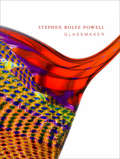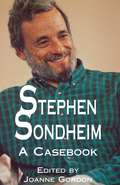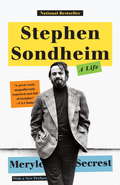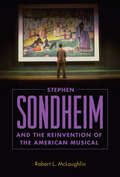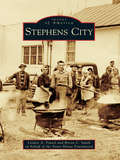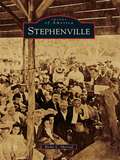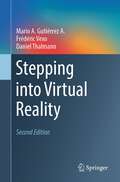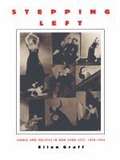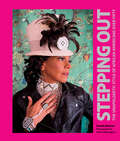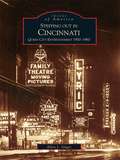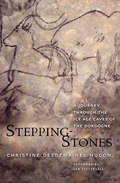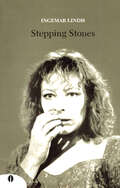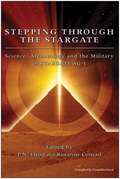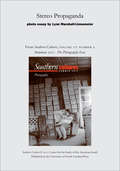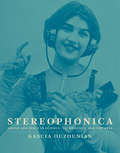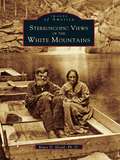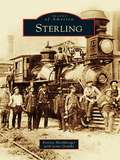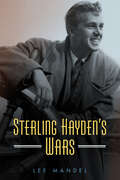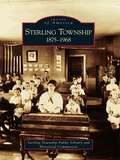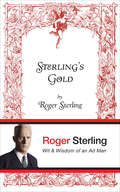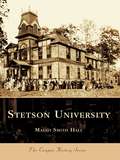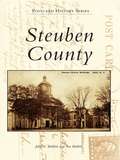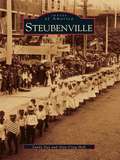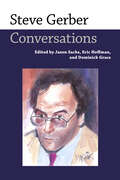- Table View
- List View
Stephen Rolfe Powell: Glassmaker
by Stephen Rolfe PowellThis definitive volume vividly chronicles the glass artist’s remarkable work and unique methods as they evolved over the course of his career.Internationally renowned glass artist Stephen Rolfe Powell created his work in a quiet outpost of rural Kentucky. The radiant murrini skins of his glass vessels have an old Italian pedigree, yet his techniques were radically American in their dramatic individuality. He stood among modern glass's most nuanced explorers of light and color.The stunning photographs in this book showcase Powell's work from different viewpoints, highlighting the unique interactions of transparent, opaque, and translucent glass and Powell's bold color combinations. Photographic close-ups detail the luminous murrini patterns that became Powell's signature, revealing new ways of appreciating the complex interplay of color and texture in his art.Biographical and analytical essays by Mark Lucas, Laurie Winters, and James Yood explore Powell's unique, team-based process; his teaching and learning experiences on the road, from the former Soviet Union to Salt Lake City during the Olympics; and the two freak injuries that deeply affected his approach to his work. Reflections by Kenn Holsten, Marvin Lipofsky, Dante Marioni, Bonnie Marx, John Roush, and Lino Tagliapietra further supplement the book.
Stephen Sondheim: A Casebook (Casebooks on Modern Dramatists #Vol. 23)
by Joanne GordonFirst Published in 1997. Routledge is an imprint of Taylor & Francis, an informa company.
Stephen Sondheim: A Life
by Meryle SecrestIn the first full-scale life of the most important composer-lyricist at work in musical theatre today, Meryle Secrest, the biographer of Frank Lloyd Wright and Leonard Bernstein, draws on her extended conversations with Stephen Sondheim as well as on her interviews with his friends, family, collaborators, and lovers to bring us not only the artist--as a master of modernist compositional style--but also the private man. Beginning with his early childhood on New York's prosperous Upper West Side, Secrest describes how Sondheim was taught to play the piano by his father, a successful dress manufacturer and amateur musician. She writes about Sondheim's early ambition to become a concert pianist, about the effect on him of his parents' divorce when he was ten, about his years in military and private schools. She writes about his feelings of loneliness and abandonment, about the refuge he found in the home of Oscar and Dorothy Hammerstein, and his determination to become just like Oscar.Secrest describes the years when Sondheim was struggling to gain a foothold in the theatre, his attempts at scriptwriting (in his early twenties in Rome on the set of Beat the Devil with Bogart and Huston, and later in Hollywood as a co-writer with George Oppenheimer for the TV series Topper), living the Hollywood life.Here is Sondheim's ascent to the peaks of the Broadway musical, from his chance meeting with play-wright Arthur Laurents, which led to his first success--as co-lyricist with Leonard Bernstein on West Side Story--to his collaboration with Laurents on Gypsy, to his first full Broadway score, A Funny Thing Happened on the Way to the Forum. And Secrest writes about his first big success as composer, lyricist, writer in the 1960s with Company, an innovative and sophisticated musical that examined marriage à la mode. It was the start of an almost-twenty-year collaboration with producer and director Hal Prince that resulted in such shows as Follies, Pacific Overtures, Sweeney Todd, and A Little Night Music.We see Sondheim at work with composers, producers, directors, co-writers, actors, the greats of his time and ours, among them Leonard Bernstein, Ethel Merman, Richard Rodgers, Oscar Hammerstein, Jerome Robbins, Zero Mostel, Bernadette Peters, and Lee Remick (with whom it was said he was in love, and she with him), as Secrest vividly re-creates the energy, the passion, the despair, the excitement, the genius, that went into the making of show after Sondheim show.A biography that is sure to become the standard work on Sondheim's life and art.
Stephen Sondheim and the Reinvention of the American Musical
by Robert L. McLaughlinFrom West Side Story in 1957 to Road Show in 2008, the musicals of Stephen Sondheim (1930–2021) and his collaborators have challenged the conventions of American musical theater and expanded the possibilities of what musical plays can do, how they work, and what they mean. Sondheim's brilliant array of work, including such musicals as Company, Follies, Sweeney Todd, Sunday in the Park with George, and Into the Woods, established him as the preeminent composer/lyricist of his, if not all, time. Stephen Sondheim and the Reinvention of the American Musical places Sondheim's work in two contexts: the exhaustion of the musical play and the postmodernism that, by the 1960s, deeply influenced all the American arts. Sondheim's musicals are central to the transition from the Rodgers and Hammerstein-style musical that had dominated Broadway stages for twenty years to a new postmodern musical. This new style reclaimed many of the self-aware, performative techniques of the 1930s musical comedy to develop its themes of the breakdown of narrative knowledge and the fragmentation of identity. In his most recent work, Sondheim, who was famously mentored by Oscar Hammerstein II, stretches toward a twenty-first-century musical that seeks to break out of the self-referring web of language. Stephen Sondheim and the Reinvention of the American Musical offers close readings of all of Sondheim's musicals and finds in them critiques of the operation of power, questioning of conventional systems of knowledge, and explorations of contemporary identity.
Stephens City (Images of America)
by Linden A. Fravel Stone House Foundation Byron C. SmithOn October 12, 1758, a newly appointed lieutenant governor of Virginia approved a set of bills passed by the colony's legislature, and the town of Stephens City, originally named Stephensburgh, was born. As the town grew over the next century and a half, its inhabitants participated in events of national significance, including the French and Indian War, the American Revolution, and the Civil War, when the town was almost burned by Union forces. Throughout its history, the town has had a reputation for labor, industry, thrift, and the overland travel and vehicle traffic associated with the modern U.S. Route 11 corridor. Where 150 years ago the town was famous for producing high-quality freight wagons, it is today a growing suburban community with residents who commute to work in the surrounding region.
Stephenville
by Ricky L. SherrodOn July 4, 1855, on the fringe of the Texas Cross Timbers frontier, John M. Stephen and George B. Erath completed the survey of the Stephenville city square. Stephenville quickly became a prosperous settlement and a center for cattle raising, cotton production, and most recently dairy production. Styled today as the "City of Champions," "Cowboy Capital of the World," and the "Dairy Capital of Texas," Stephenville has a colorful 155-year history. The evolution from cattle ranching to dairy farming finds delightful expression on the original town square where Moo-la--a life-size fiberglass Holstein milk cow--celebrates Stephenville's agricultural achievements. "The 'Ville" has produced football heroes such as 1938 NFL Champion New York Giants fullback Hugh Wolfe and 2010 Philadelphia Eagles quarterback Kevin Kolb and rodeo champions Whit Keeney, Tuff Hedeman, and "King of the Cowboys" Ty Murray. Music celebrities Lee Roy Parnell, Johnny Duncan, Larry Joe Taylor, and Jewel have also called Stephenville home.
Stepping into Virtual Reality
by Mario A. Gutiérrez A. Frédéric Vexo Daniel ThalmannVirtual reality techniques are increasingly becoming indispensable in many areas. This book looks at how to generate advanced virtual reality worlds. It covers principles, techniques, devices and mathematical foundations, beginning with basic definitions, and then moving on to the latest results from current research and exploring the social implications of these. Very practical in its approach, the book is fully illustrated in colour and contains numerous examples, exercises and case studies. This textbook will allow students and practitioners alike to gain a practical understanding of virtual reality concepts, devices and possible applications.
Stepping Left: Dance and Politics in New York City, 1928–1942
by Ellen GraffStepping Left simultaneously unveils the radical roots of modern dance and recalls the excitement and energy of New York City in the 1930s. Ellen Graff explores the relationship between the modern dance movement and leftist political activism in this period, describing the moment in American dance history when the revolutionary fervor of "dancing modern" was joined with the revolutionary vision promised by the Soviet Union. This account reveals the major contribution of Communist and left-wing politics to modern dance during its formative years in New York City. From Communist Party pageants to union hall performances to benefits for the Spanish Civil War, Graff documents the passionate involvement of American dancers in the political and social controversies that raged throughout the Depression era. Dancers formed collectives and experimented with collaborative methods of composition at the same time that they were marching in May Day parades, demonstrating for workers' rights, and protesting the rise of fascism in Europe. Graff records the explosion of choreographic activity that accompanied this lively period--when modern dance was trying to establish legitimacy and its own audience. Stepping Left restores a missing legacy to the history of American dance, a vibrant moment that was supressed in the McCarthy era and almost lost to memory. Revisiting debates among writers and dancers about the place of political content and ethnicity in new dance forms, Stepping Left is a landmark work of dance history.
Stepping Out: The Unapologetic Style of African Americans over Fifty
by Connie BriscoeAn unapologetically bold, stimulating, and inspired collection of photographs and profiles celebrating the style of African Americans age 50+Long inspired by mature adults daring to express their creativity and individuality through their style choices, New York Times bestselling novelist Connie Briscoe shines a light on these often overlooked and underappreciated sharply attired individuals. Accompanied by the marvelously talented Milton Washington&’s dazzling photographs, Briscoe&’s vision comes alive in these pages. From intrepid to chic, and sophisticated to free-spirited—Stepping Out captures the very essences of a vibrant cross section of Black elders, showcasing their stories, their styles, and how their love of fashion was born and bred. This book contextualizes the cultural, spiritual, and historical influences on decades of Black style and testifies to this dynamic legacy for generations to come.
Stepping out in Cincinnati: Queen City Entertainment 1900-1960
by Allen J. SingerLong before folks had a television set and radio in every room, they sought entertainment by stepping out for a night on the town. The choices around Cincinnati were nearly limitless: live theater at the Cox; spectacular musicals at the Shubert; hotels featuring fine dining and dance orchestras; talking pictures at everyone's favorite movie palace--the Albee; burlesque and vaudeville shows at the Empress Theater on Vine Street; and gambling casinos were just a short drive across the river in Newport. All of the major entertainment venues in the Queen City during the first half of the 20th century are explored in Stepping out in Cincinnati. From saloons to ornate movie palaces and from the Cotton Club to the Capitol, you join those pleasure seekers, getting a real sense of what they saw: wonderful events and their countless images--the things of which fond memories were made. Today, those memories have faded and virtually all of the once-glittering showplaces have been bulldozed into history. But within these pages, we get to experience first hand what it was like to be there. Unique among the many photographs featuring unforgettable movie houses and nightclub orchestras are never-before-published images of actual live vaudeville performances onstage at the Shubert, plus rare, clandestine pictures snapped inside the casinos in Newport. Also revealed are the locations of the better-known speakeasies during Prohibition; where the best halls to dance to live orchestras were; what the earliest movie houses were like; and what black Cincinnatians did for entertainment.
Stepping-Stones: A Journey through the Ice Age Caves of the Dordogne
by Christine Desdemaines-Hugon&“The next best thing to actually seeing the prehistoric cave art of southern Franc[e] . . . A rapturous guide through five major Ice Age sites&” (Archaeology). The cave art of France&’s Dordogne region is world-famous for the mythology and beauty of its remarkable drawings and paintings. These ancient images of lively bison, horses, and mammoths, as well as symbols of all kinds, are fascinating touchstones in the development of human culture, demonstrating how far humankind has come and reminding us of the ties that bind us across the ages. Over more than twenty-five years of teaching and research, Christine Desdemaines-Hugon has become an unrivaled expert in the cave art and artists of the Dordogne region. In Stepping-Stones she combines her expertise in both art and archaeology to convey an intimate understanding of the &“cave experience.&” Her keen insights communicate not only the incomparable artistic value of these works but also the near-spiritual impact of viewing them for oneself. Focusing on five fascinating sites, including the famed Font de Gaume and others that still remain open to the public, this book reveals striking similarities between art forms of the Paleolithic and works of modern artists and gives us a unique pathway toward understanding the culture of the Dordogne Paleolithic peoples and how it still touches our lives today. &“Her vivid descriptions help readers visualize the Cro-Magnon man or woman painting the beautiful bison, horses, mammoths, and other symbols. [A] fine reading experience.&” —Library Journal
Stepping Stones (Routledge Icarus Ser.)
by Ingemar LindhStepping Stones is the book of a practitioner. It documents the work of a laboratory-based practice that investigated the principles of collective improvisation as a performance practice.
Stepping Through The Stargate: Science, Archaeology And The Military In Stargate Sg1
by P.N. Elrod and Roxanne ConradExplore the Stargate SG-1 universe as never before with the expertise and insight of noted professionals from a diverse range of fields: from archaeology to parasitology to science fiction, is a fascinating collection of essays that delve into every aspect of Stargate with the same humor and intellectual curiosity of the show itself.
Stereo Propaganda
by Lynn Marshall-LinnemeierOld photographs meet new color, creating thoughtful new meanings. This article appears in the Summer 2011 issue of Southern Cultures: The Photography Issue. "In this examination, magic and myth-two of my favorite vehicles-act as buffers to the dominant power structure. It brings together two bodies of collectibles, one personal and one commercial, with the intent of shifting stereotypes about race and southern culture."
Stereo Scene Flow for 3D Motion Analysis
by Daniel Cremers Andreas WedelThis book presents methods for estimating optical flow and scene flow motion with high accuracy, focusing on the practical application of these methods in camera-based driver assistance systems. Clearly and logically structured, the book builds from basic themes to more advanced concepts, culminating in the development of a novel, accurate and robust optic flow method. Features: reviews the major advances in motion estimation and motion analysis, and the latest progress of dense optical flow algorithms; investigates the use of residual images for optical flow; examines methods for deriving motion from stereo image sequences; analyses the error characteristics for motion variables, and derives scene flow metrics for movement likelihood and velocity; introduces a framework for scene flow-based moving object detection and segmentation; includes Appendices on data terms and quadratic optimization, and scene flow implementation using Euler-Lagrange equations, in addition to a helpful Glossary.
Stereophonica: Sound and Space in Science, Technology, and the Arts
by Gascia OuzounianEpisodes in the transformation of our understanding of sound and space, from binaural listening in the nineteenth century to contemporary sound art.The relationship between sound and space has become central to both creative practices in music and sound art and contemporary scholarship on sound. Entire subfields have emerged in connection to the spatial aspects of sound, from spatial audio and sound installation to acoustic ecology and soundscape studies. But how did our understanding of sound become spatial? In Stereophonica, Gascia Ouzounian examines a series of historical episodes that transformed ideas of sound and space, from the advent of stereo technologies in the nineteenth century to visual representations of sonic environments today.Developing a uniquely interdisciplinary perspective, Ouzounian draws on both the history of science and technology and the history of music and sound art. She investigates the binaural apparatus that allowed nineteenth-century listeners to observe sound in three dimensions; examines the development of military technologies for sound location during World War I; revisits experiments in stereo sound at Bell Telephone Laboratories in the 1930s; and considers the creation of "optimized acoustical environments" for theaters and factories. She explores the development of multichannel "spatial music" in the 1950s and sound installation art in the 1960s; analyzes the mapping of soundscapes; and investigates contemporary approaches to sonic urbanism, sonic practices that reimagine urban environments through sound.Rich in detail but accessible and engaging, and generously illustrated with photographs, drawings, maps, and diagrams of devices and artworks, Stereophonica brings an acute, imaginative, and much-needed historical sensibility to the growing literature around sound and space.
Stereoscopic Views of the White Mountains (Images Of America Ser.)
by Bruce D. HealdFor more than 150 years, the White Mountains have attracted untold numbers of visitors from all over the world. The lofty peaks offer unlimited panoramas the view from the summit of Mount Washington extends for more than 100 miles in all directions and includes 33 other mountaintops, each with an elevation exceeding 4,000 feet. Framing the Presidential Range are Crawford Notch, Franconia Notch, and Pinkham Notch, three of the most impressive wonders in the eastern part the country. The White Mountain region has numerous other points of interest: the Flume, the Pool, the Basin, the Old Man of the Mountain, Glen Ellis Falls, the Lake of the Clouds, Echo Lake, Profile Lake, and the White Horse Ledge, to name a few. The stereo technique dates from the earliest years of photography. Stereo photographs are two images of the same view taken from slightly different points, which when observed through special glasses appear as one with an added dimension of depth. Photographers took these three-dimensional views to exemplify and to preserve in print the beauty, wonders, and wealth of nature. Stereoscopic Views of the White Mountains contains more than 200 reflective stereos of the region's mountains, lakes, rivers, and streams. These breathtaking views of the landscape, the resorts, and the villages were taken during an excursion on the early railroads. They recall the romance and idealism of the rail and stagecoach era.
Sterling (Images of America)
by Forrest Hershberger Jenni GrubbsThe city of Sterling in northeast Colorado is at a crossroads of several trails historically and modern roads and highways today. The area was once inhabited by the Arapahoe, Cheyenne, Crow, Blackfoot, Sioux, Kiowa, and Pawnee tribes. The earliest Europeans were fur trappers on their way to the Colorado Mountains. The Sterling area is also noted for one of the final battles of the Indian wars, the battle of Summit Springs, between Tall Bull's Cheyenne Dog Soldiers and Col. Eugene A. Carr and the U.S. Army, southeast of Sterling on July 11, 1869. Today the city of Sterling is the county seat for Logan County. It is located at the junction of the South Platte River, Interstate 76, and Highways 6, 14, 61, and 138. Its history as an agricultural community is still a vital part of the economy and culture. Many of the celebrations seen in this book are annual events today, including the county fair and Sugar Beet Days.
Sterling Hayden's Wars (Hollywood Legends Series)
by Lee MandelA master sailor when he was barely in his twenties, Sterling Hayden (1916-1986) became an overnight film star despite having no training in acting. After starring in two major films, he quit Hollywood and trained as a commando in Europe. Hayden joined the OSS and fought in the Balkans and Mediterranean, earning a Silver Star for his distinguished service. Hayden's wartime admiration for the Yugoslavian Partisans led to a brief membership in the Communist Party after the war, and this would come back to haunt him when he was called to testify in front of the House Un-American Activities Committee where he became the first star to name names.After returning to Hollywood, Hayden's film career flourished as he starred in several films including The Asphalt Jungle, Denver and Rio Grande, and The Killing. His personal life, however, descended into chaos. His bitter custody battle with his second wife led to his well-publicized and controversial kidnapping of their four children for a voyage to Tahiti. Increasing alcohol and substance abuse would take its toll, but Hayden's career would be revived as a character actor in such classics as Dr. Strangelove and The Godfather. In addition, he proved to be an excellent author, penning two international bestsellers.Despite these achievements, his later years were characterized by depression, self-doubt, alcoholism, and substance abuse. His life was metaphorically a series of wars, including the most difficult of them all--the war that Sterling Hayden fought with himself.
Sterling Township: 1875-1968 (Images of America)
by Sterling Township Public Library and Historical CommisionSterling Township, located about 18 miles northeast of Detroit, was first settled after the Erie Canal was opened. The rich soil, relatively flat land, and the vital Clinton River attracted pioneer and immigrant families who arrived to establish farmsteads. The first influx of immigrants came mainly from the British Isles, and by the 1870s, Germanfamilies had flocked to the area, raising dairy cattle andestablishing farms. Belgians, arriving in the early 1900s,developed truck farming--growing fruits and vegetablesto sell every week at the farmers' market in Detroit. Farmculture prevailed until the 1950s, when large industrialplants began moving in, bringing with them workers anda need for housing and city services. Sterling Townshipbecame the city of Sterling Heights in 1968, and thiscollection of photographs will showcase the families andthe way of life in the early days of this community, ahistoric community that is now the fourth largest city in Michigan.
Sterling's Gold: Wit and Wisdom of an Ad Man (Books That Changed the World)
by Roger SterlingQuips and quotes from one of Mad Men’s sharpest wits.Multiple Emmy winner Mad Men continues to captivate viewers around the world with its brilliant portrayal of the 1960s and its stylish characters, including the dashing advertising mogul Roger Sterling, who’s acquired a reputation for his quips, barbs, and witticisms over the show’s many season. This book, presented as Roger’s memoir during the fourth season of Mad Men, is an entertaining collection of our favorite ad man’s best one-liners.Roger Sterling’s pithy comments and observations amount to a unique window into the advertising world—a world that few among us are privileged to witness firsthand—as well as a commentary on life in New York City in the middle of the twentieth century.
Stetson University (Campus History)
by Maggi Smith HallStetson University, founded in 1883 in historic DeLand, Florida, has been educating students for over a century thanks to the passionate vision of the town's early promoter, Henry Addison DeLand. DeLand, a New Yorker with a dream, wanted his newly adopted town to be distinctive in rural Central Florida. Since the state had no four-year college, his foresight brought to fruition the excellent educational facility we have today.
Steuben County
by John S. Babbitt Sue BabbittLocated in the Finger Lakes region, Steuben County has seen industries like glass and brick-making factories, railroad shops, and clothing mills spring up over time. Early transportation grew when people with canal fever followed water routes to the Erie Canal, while railroads crisscrossed the county and improved travel. Grape growing flourished, and in the last 149 years, this industry has brought prosperity to the entire Finger Lakes region. In 1868, the Corning Flint Glass Works arrived in Corning and was the first of many glass-making shops established in the area. The railroad provided laborers as well as a means of bringing in supplies and shipping out finished products, allowing the glass industry to flourish in the Chemung River Valley.
Steubenville (Images of America)
by Alan Craig Hall Sandy DayNamed after a Prussian officer who aided America during the Revolution, Fort Steuben was constructed in 1786 to protect government surveyors of the Old Northwest Territory. In 1797, Steubenville, one of the earliest settlements in Ohio, was founded and named after the fort. Located on the Ohio River, the town became a hub of transportation, bringing in settlers and industry. By the 20th century, Steubenville had become a center for steel production and coal mining. Important figures President Abraham Lincoln's Secretary of War Edwin M. Stanton, sports commentator "Jimmy the Greek," and entertainer Dean Martin all are natives of Ohio's eastern gateway, Steubenville.
Steve Gerber: Conversations (Conversations with Comic Artists Series)
by Jason Sacks, Eric Hoffman and Dominick GraceSteve Gerber (1947–2008) is among the most significant comics writers of the modern era. Best known for his magnum opus Howard the Duck, he also wrote influential series such as Man-Thing, Omega the Unknown, The Phantom Zone, and Hard Time, expressing a combination of intelligence and empathy rare in American comics. Gerber rose to prominence during the 1970s. His work for Marvel Comics during that era helped revitalize several increasingly clichéd generic conventions of superhero, horror, and funny animal comics by inserting satire, psychological complexity, and existential absurdism. Gerber's scripts were also often socially conscious, confronting, among other things, capitalism, environmentalism, political corruption, and censorship. His critique also extended into the personal sphere, addressing such taboo topics as domestic violence, racism, inequality, and poverty. This volume follows Gerber’s career through a range of interviews, beginning with his height during the 1970s and ending with an interview with Michael Eury just before Gerber’s death in 2008. Among the pieces featured is a 1976 interview with Mark Lerer, originally published in the low-circulation fanzine Pittsburgh Fan Forum, where Gerber looks back on his work for Marvel during the early to mid-1970s, his most prolific period. This volume concludes with selections from Gerber’s dialogue with his readers and admirers in online forums and a Gerber-based Yahoo Group, wherein he candidly discusses his many projects over the years. Gerber’s unique voice in comics has established his legacy. Indeed, his contribution earned him a posthumous induction into the Will Eisner Comic Book Hall of Fame.
